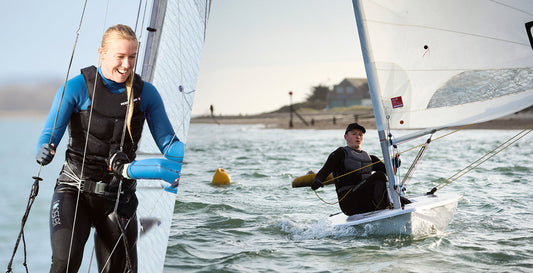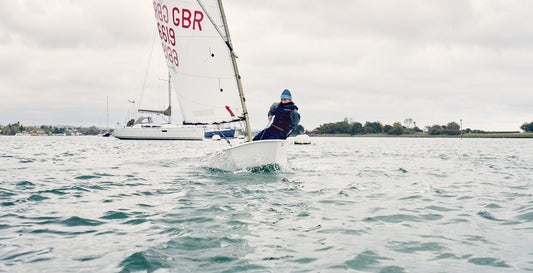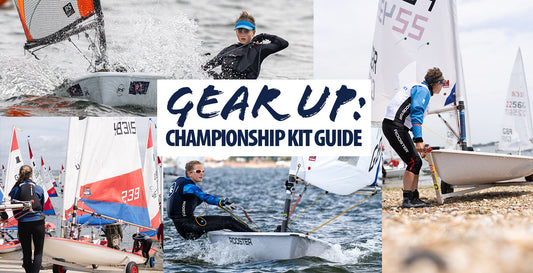GEAR GUIDE
Not sure what to wear on the water? Our Gear Guide is here to help you choose the right gear for every condition. Whether you're learning about the benefits of Aquafleece, figuring out the best layers for warmth and comfort, or just starting out, these guides from Rooster will keep you informed and prepared.
Blog posts
Junior Winter Kit: How to Keep Young Sailors Warm This Season
When the temperature drops, sailing doesn’t have to stop. With the right layers and smart kit choices, winter sailing can be just as rewarding as summer — sometimes even more so. For junior sailors, learning how to stay warm and dry on the water is a key part of growing in the sport.
At Rooster, we’ve spent years developing kit that works as hard as the sailors wearing it — gear that keeps young sailors confident, comfortable, and ready to face the chill head-on.
Why the Right Winter Kit Matters
Cold conditions can make or break a training session. It’s hard to focus on racing tactics or boat handling when you’re distracted by numb fingers or shivering. Proper layering helps young sailors stay safe and comfortable — and most importantly, enjoy every moment on the water.
Rooster Rider Amelie Ballantyne puts it best:
“Once you’re warm and dry, everything changes. You can focus on sailing — not surviving. My top tip is to block the wind BEFORE you get wet. Wind chill is your number one enemy and it’s hard to warm up if you’re already cold and wet. I always wear my Pro Aquafleece Top to keep warm"
What Our Riders Recommend
We asked our Rooster Riders to share their top layering tips for winter sailing — the things they wish they’d known before their first cold session.
Their advice all points to the same truth: getting layering right means you’ll stay on the water longer, sail better, and have more fun.
The Junior Winter Kit System
Here’s a simple layering setup our Riders swear by:
1. Base Layer – Polypro or ‘Hot’ Top & Leggings
A warm, stretchy yet thin foundation that regulates body temperature without restricting movement.
2. Mid Layer (Wetsuit layer) – Supertherm 4mm Longjohn and Top
The powerhouse of your winter kit. Neoprene creates a dynamic thermal barrier by trapping a thin layer of water and maintaining your core temperature, all while offering stretch and freedom of movement for active sailing.
3. Outer Layer – Aquafleece Spray Top
Your essential weather shield, perfect for throwing on over your base. Protects against spray, rain, and wind chill — keeping core warmth in and water out.
4. Accessories – Gloves, Boots, and Hats
Often underestimated but crucial. Warm extremities = happy sailor.
Shop Junior Winter Kit
Layer up, Sail on…
Great kit doesn’t just keep you warm — it builds confidence. When juniors can focus on their technique rather than the temperature, they develop faster, stay positive, and actually look forward to those early winter starts.
That’s what we love to see at Rooster — young sailors who are comfortable, capable, and ready to take on any conditions.
Explore our Rider-approved winter essentials for junior sailors and help your sailor stay warm, dry, and ready for every challenge this season.
Read more about the right layers for you on our Layering Guide
Why Upgrade to a 4mm Wetsuit for Winter Sailing?
Winter sailing can be some of the most rewarding time on the water — crisp mornings, steady breezes, quieter waters. But with colder conditions comes one big challenge: staying warm. Your wetsuit is your first line of defence, and choosing the right thickness is critical. Here’s why upgrading to a Supertherm 4mm wetsuit can transform your cold-weather sailing experience.
Quick Look:
1. How Neoprene Keeps You Warm
Neoprene works by trapping a thin layer of water between your body and the suit. Your body heats this water, creating an insulating barrier. The thicker the neoprene, the more insulation it provides — making it much harder for heat to escape.
2. Why Thickness Matters
1.5mm neoprene (like our Thermaflex) offers flexibility and comfort for mild to warm conditions.
4mm neoprene (like the Supertherm) adds serious insulation for cold-weather training, helping you retain heat for longer sessions.
Think of it like the difference between a light jacket and a winter coat — both have their place, but when the cold bites, you’ll want the thicker layer.
3. Advanced Linings for Extra Warmth
The Supertherm 4mm range isn’t just thicker — it’s smarter. Enhanced linings wick moisture away from your skin, add thermal comfort, and dry faster between sessions. That means less of the “chill factor” when you put your wetsuit back on for the afternoon race.
4. The Role of Stitching: Flatlock vs GBS
Not all seams are created equal.
Flatlock stitching (used in thinner suits like Thermaflex) is breathable but allows small amounts of water through — fine for warmer sailing.
GBS (Glued and Blind Stitched) seams, used in all our Supertherm range, are sealed to minimise water entry. This keeps the insulating layer of water more stable and your body much warmer.
5. Designed for Winter Performance
Sailors often assume thicker neoprene means restricted movement — not with Supertherm. Our panels are engineered for stretch and flexibility where you need it most, so you stay agile and comfortable while still benefiting from maximum warmth.
6. Pairing with Other Layers
The Supertherm range is built to be part of your complete winter system. Layer it up with:
· Thermal base layers like our Polypro or Hot tops & leggings — not only do they help manage moisture, but they also add an extra insulating layer, trapping air and boosting warmth.
· Spray protection such as the Aquafleece® or SB1 Inshore Dry Smock — your outer defence against wind and water.
Together, these layers create a system that locks in heat, keeps you dry, and stands up to whatever winter sailing throws at you. Read more about layering by visiting our Layering Guide.
Don’t let the cold hold you back. With the right wetsuit, winter sailing can be just as enjoyable — if not more — than the summer season. Our Supertherm 4mm range is designed to give you the warmth, comfort, and performance you need to sail on through the colder months.
Winter Training Layering Tips
Winter doesn’t mean your sailing or training has to stop – it just means you need to prepare your kit properly. The right layering system will keep you warm, dry, and able to focus on performance instead of the cold. At Rooster, we’ve refined our layering philosophy so every piece works together, giving you flexibility whether you’re racing, coaching, or training ashore. You can check out our full layering guide for tips throughout the year, but for Autumn/Winter specific keep reading below:
The Golden Rule: Layer Like an Onion
Layering is about trapping warm air close to your body while managing moisture and protecting against wind and spray. Each layer has a job to do, and when combined, they deliver comfort and performance in even the harshest conditions.
Think of this as your second skin. Its job is to regulate body temperature and wick moisture away, keeping you dry even when you’re working hard.
Technical base layers: Soft, quick-drying fabrics prevent chills caused by sweat.
Close-fitting design: Ensures no cold gaps and allows easy layering on top.
Rooster Pick: Hot Top & Leggings – the winter sailor’s secret weapon.
Top tip: Skip rash vests or Lycra layers as insulation – they won’t add warmth and can actually make you feel cooler. When it comes to layering, sometimes less really is more.
This is where you add warmth. Choose pieces that are flexible, breathable, and easy to peel off when conditions change.
Flexible layering: Adjust your neoprene thickness to match the forecast. When the temperature drops below 15°C, reach for your Supertherm® 4mm Top and Longjohn for maximum warmth. In milder conditions, your Thermaflex® 1.5mm layers may be all you need – and if you’re someone who feels the cold, add extra base layers for comfort. When it is really really cold, you could double up on neoprene!
Check out our blog on what the forecast says vs the actual temperatures.
Your shell is the barrier against wind, spray, and rain. Look for waterproofing, breathability, and freedom of movement.
Aquafleece Spray tops or SB1 Inshore Smock: Great for dinghy sailing.
SB1 Jacket or Pro Rigging Jacket: Added protection when conditions are rougher.
Your hands, feet, and head lose heat fastest, so finishing your system with quality accessories is vital.
Neoprene gloves & mitts for grip and warmth.
Neoprene socks layered under boots for warm, dry feet.
Hats, beanies, neck gaiters & balaclavas to prevent heat loss from your head and neck.
💡 Did you know? Research published in the British Medical Journal found that if your head is the only part of your body uncovered, you can lose around 7–10% of your body heat through it. A simple hat or hood can make a huge difference to your comfort and endurance on the water.
Customer Favourite Pick for Autumn/Winter Training: AquaPro Gloves, Hot Socks, Supertherm Beanie & Aquafleece Neck Gaiters.
One of the toughest parts of winter training is when the day is split into two sessions with downtime in between. That mid-day break can be when the cold really creeps in, leaving you feeling flat, sluggish, and unmotivated for round two. The good news? With a few smart habits, you can stay warm, recover properly, and head back out ready to perform.
Top tips for staying warm between sessions:
Layer up quickly: Throw on a warm, windproof outer layer such as our Pro Aquafleece® Rigging Coat or Aquafleece® Robe to trap heat and stop the chill setting in.
Swap your kit: Take a spare pair of socks and gloves to change into during the break – dry, warm hands and feet make a huge difference.
Don’t forget your head: A simple beanie helps keep body heat in and makes you feel instantly warmer.
Refuel smartly: Pack proper food and a hot drink to top up energy levels and keep your core temperature steady.
Keep moving: Light activity between sessions helps circulation and stops you from cooling down too much.
Avoid rash/lycra layers – they hold water and makes you cold.
Stay flexible – pack an extra mid-layer, socks and gloves in your kit bag so you can adapt.
Check your fit – layers should sit comfortably without restricting movement.
Look after your gear – rinse saltwater off regularly and let items dry fully.
Final Thought: Winter sailing and training are all about preparation. Get your layering right, and you’ll be warm, comfortable, and ready to perform – whatever the weather throws at you.
Our full layering guide and more information on layering for different conditions can be found here.
Gear Up: Your Essential Kit Guide for Summer Sailing Champs
Summer sailing and regattas often mean long hours on the water — sometimes with three or more races back to back. If you’re new to it, or haven’t raced in a while, knowing what to wear or take with you can feel overwhelming. For the seasoned sailor, it’s often second nature — but even the most experienced can get caught out when they’re a bit rusty or just haven’t had to prep for a full championship day in a while.
Even simple logistics can throw you off: can you drop a drybag on a rib? If so, great — you have more flexibility. But if you’re scrambling to find that rib between races or the next warning signal goes up right after the finish, you could be left without the gear you were counting on.
Just like any endurance sport, sailing demands planning — for clothing, food, and hydration. The goal? Bring what you need without overpacking. Most dinghies don’t have room for your entire wardrobe and snack cupboard.
Pack too much and it's dead weight; pack too little and, inevitably, that’s the day you needed that extra layer or snack bar.
The Weather Never Makes it Easy
British summer sailing is unpredictable. Sure, we all know the signs — clouds building inland, a sea breeze on the way — but forecasts rarely tell the full story. The “real feel” out on the water can be wildly different from what was expected. We've written a blog on this which is well worth a read. Read more.
When you’re 2 hours from shore in a dinghy, you have to be self-reliant. Even at a big event surrounded by boats and safety cover, you need to look after number one. That means having the right gear, fuel, and backup layers — because when the unexpected happens, you want to be ready.
Fuel Matters: Food & Hydration
Outfit choices are only half the battle. Staying fuelled and hydrated is critical for performance and recovery — especially over back-to-back races.
Your Championship Kit Guide: What to Wear, What to Pack
We’ve created a simple guide to help you layer up, pack smart, and stay comfortable during race days — whether it’s a short session or an all-day affair.
Your Standard Base Kit
Based on a mild Summer | 20–28°C
Top layer: Rash top or PolyPro top
Rash = cooler, UV protection
PolyPro = extra warmth + UV, fleece-lined
Bottom half: Thermaflex 1.5mm Longjohn or Race Armour Lite Shorts
Buoyancy Aid
Aeromesh Cap – protects your head & aids ventilation
UV Neck Sleeve – adds sun protection
Boots – suitable for your boat and grip needs
Sunglasses – ideally with a retainer
Long Day on the Water
(3–5 hours | 3–4 races back-to-back | 20–28°C)
UV lip balm / small suncream
Cereal or oat based bar (slow-release energy)
Gel, sweets or fruit (fast-release energy)
On Board:
2x large water bottles
1 water, 1 electrolytes (use a Joey Bottle Holder)
Drybag - 10L Rolltop Drybag - perfect for on the boat or 35L Dry Backpack - if you have access to a rib to store:
Lightweight spray top or SB1 dry smock
Spare warmer layer (PolyPro or Thermaflex top)
Suncream
Lunch/snacks
Shorter Day on the Water
(1–2 hours | 1–2 races back-to-back | 20-28°C)
Pockets:
UV lip balm
Mini suncream
Snack bar
On Board:
1–2 large drinks bottles (again, ideally one with electrolytes)
Joey Bottle Holder
Drybag - 3L Rolltop Drybag:
Lightweight spray top or Thermaflex top
Extra snack
Suncream
Bonus Kit: Things You Might Be Glad You Brought!
Spare rope/lines
Whistle
Knife
Duck tape (“If you can’t fix it with duck tape…”)
Electrical tape
Spare shackles/blocks/split pins
Sail repair tape
Multi-tool
Emergency blanket
Phone or VHF radio
Long days on the water are where championships are won and lost, and your preparation can make a huge difference. Pack smart, dress for the conditions, and fuel your body properly. That way, you’ll be focused on racing, not worrying about what you left behind.
SB1 Inshore Smock: Neck Seal Adjustment Guide
The SB1 Inshore Dry Smock is built to keep you dry and protected in a wide range of sailing conditions. At the heart of its performance is the neoprene neck seal, which provides a near-dry seal for inshore and coastal sailing. But comfort is key too — and we know that not everyone has the same neck length or preferences when it comes to feel.
That's why we’ve designed the neck to be fully customisable.
Below is an easy step-by-step guide to adjusting the neck seal for a personalised fit. Rooster founder, Steve Cockerill also explains via video why you might want to trim the neoprene neck seal and explains an alternative method if you don’t need a fully dry seal and want a softer feel next to your skin.
Watch the video below or head to our youtube channel for more videos:
Why the Neck Seal Is Made This Way
The SB1’s neoprene neck is intentionally manufactured at its longest setting — suitable for those with longer necks or those seeking maximum protection. But we know that for many sailors, this can feel a little high. Fortunately, it’s easy to customise.
Option 1: Trim to Your Neck Length
If you want a more tailored fit, you can trim the neoprene down at the front. Here’s how:
How to Trim the Neck Seal:
Try It On FirstPut the smock on and assess how much material you’d like to remove for comfort. Start conservatively — it’s better to take a little off at a time.
Mark the Cut LineUse a soft pencil or tailor’s chalk to draw a shallow curve at the front of the neck. Most people choose to take off a small crescent from the centre front, tapering off at the sides.
Use Sharp ScissorsCut slowly and cleanly along your marked line. A sharp pair of fabric or neoprene scissors works best. Avoid jagged edges.
Test and AdjustTry the smock on again. You can always take a little more off if needed — but you can’t put it back!
Note: Cutting the neck will compromise the original dry-seal design slightly, but many sailors find this trade-off worth it for improved comfort in moderate conditions.
Option 2: Roll the Neck Inward
If you'd rather not cut the neck — or want to keep the dry-seal option for future sessions — there’s another simple trick.
How to Roll the Neck for Comfort:
Fold the top of the neoprene neck in on itself, so the sticky glideskin layer (which provides the dry seal) is no longer touching your skin.
This results in a softer feel and slightly looser fit — ideal for warmer days or when you don’t need full waterproofing.
This method gives you the flexibility to adjust the seal depending on conditions, without permanently altering the smock.
At Rooster, we believe kit should work with you. Whether you choose to trim the neoprene or roll it in, the SB1 Inshore Smock is designed to give you control over your comfort and performance on the water.
Designed by Women, for Women: The Journey Behind Our Women’s Technical Shorts
At Rooster, we believe technical clothing should work with you, not stand in your way. That’s why the development of our Women’s Technical Shorts 2.0 has been a carefully considered process - over three years of dedicated development, shaped by feedback, expertise, and a clear vision for performance. These aren’t just another pair of shorts -they’re the result of listening to women, testing with women, and designing for real bodies and real sailing conditions.
Built to Fit Real Women
From the very start, our mission was clear: to create a pair of technical sailing shorts that actually fit women — of all shapes, sizes, and heights — while still offering a clean look that could blend into everyday wear. We didn’t want a “pink it and shrink it” version of our men’s shorts. We wanted something that worked because it was built for women, not in spite of it.
Luckily, we have the perfect team to help. Our office is full of active women — sailors, runners, climbers, rowers — all passionate about outdoor sport and technical performance. Their honest, practical feedback helped us fine-tune the cut, waistband height, dial in the leg length, and perfect the stretch and movement across sizes.
When we were closer to what felt like a final product, we brought in a small focus group of female sailors and outdoor enthusiasts to test a full size set — from the smallest to the largest. These weren’t models or marketing faces — they were real women, with valuable insights. We built this group through an open call on our social media channels inviting keen sailors to give their feedback and help us refine the final design.
Their feedback? Invaluable. From tweaks in the waistband construction, to how the fabric felt, to thoughts on the colourway and styling — they shaped what you now see as the final product.
I am impressed with the fact that Rooster is trying to find improved fitting women’s clothing . It was interesting to be part of this process and see the effort that goes into choosing the design. - Sam Norton (part of our focus group)
Why It Took Over 3 Years
In truth, launching a women’s-only technical product is a big decision for us. The market for female sailing gear is smaller, and factory minimum order quantities (MOQs) don’t always make it easy. But this project mattered, not just for the product itself, but because we know how valuable good kit is for women who are active in the sport.
Over the past decade, Rooster’s range has evolved to include female alternatives to most of our key products. When we can, we create female-specific options. And when that’s not viable, we always consider women’s fit when designing unisex products, making sure they’re as versatile and inclusive as possible.
We understand that introducing a women’s-specific short meant getting every detail right, and doing it when the brand was in a strong position to deliver it well.
This isn’t just about launching a new product — it’s part of a bigger commitment. At Rooster, we’re proud to support women at every level of sailing, from grassroots participation to high-performance racing. Our involvement in initiatives like the Women’s Open Keelboat Championship (WOKC), the Magenta Foiling Project, and our continued support across sportsboat classes, including the J/70s, reflects just the start of where we’re heading.
Women still make up a smaller share of active sailors — estimated at just 20–25% globally, and often less in technical classes like sportsboats and keelboats. But that number is growing, and we’re proud to be part of that progress.
For us, inclusivity and innovation in women’s technical gear isn’t an add-on — it’s a core part of what we do.
Where Function Meets Purpose
We’re excited to launch our Women’s Technical Shorts 2.0 and can’t wait to share the product we have been working on, they combine:
A flattering, technical cut designed for active movement.
Optimised waist height for support and comfort.
Stretch and flexibility where it matters most.
Ideal leg length for both comfort and coverage.
Reinforced, durable fabric at the seat — built to handle high-wear areas and long hours on deck.
Smart, functional features right where you need them — including leg pockets, belt loops for a safety knife, internal compartments for optional deck pads, a secure waist closure, and more.
And of course — they’re built from the same trusted technical foundations as our much-loved men’s shorts, which have seen five years of proven performance on the water.
We can't wait for you to try them, find out some more on our video below:
Class by Class: What our Sailors Really Wear
When it comes to sailing, what you wear can make or break your time on the water. Whether you're out racing, cruising or training, the right outfit ensures comfort, performance, and safety.
Different boat classes demand different gear — from technical clothing designed to keep you dry and warm to lightweight, breathable layers perfect for racing hard in Spring conditions.
In this guide, with the help of some of our Riders, we’ll break down the best sailing outfit ideas tailored to each class, helping you gear up with confidence in a temperature range of 10-15 degrees, no matter what kind of sailing you’re into.
RS AERO
Sammy
Base Layer - Rash Top-Long Sleeved
Mid Layer - Pro Hikers 4/3mm (Fixed Battens)
Top Layer - SuperTherm 4mm Top
Extras - Custom Race Bib, Rooster Cap (Structured), Supertherm 4mm Wet Socks, Pro Laced Boots and Race Armour Buoyancy Aid
RS21
Liam
Base Layer - Tech Shorts and Long-Sleeve UV Top and/or Poly Pro's
Mid Layer - Hybrid Jacket or a Fleece
Top Layer - Light Weight Spray Top and/or SB1's
Extras - Hat, Deck Shoes
49erFX
Emilie and Julie
Base Layer - Women's PolyPro Top
Mid Layer - Women's SuperTherm 4mm Long John
Top Layer - Classic ThermaFlex 1.5mm Top – Unisex and Women's Classic Aquafleece Top
Extras: Buoyancy Aid, Race Bib, Gloves, Boots, Trapeze Harness
OPTIMIST
Amélie
Base Layers - Poly Pro Top and Leggings
Mid Layer - Thermaflex 1.5mm Long John’s
Top Layer - Classic Aquafleece Top
Extras - All Purpose Boots, Rooster Cap and Poly Pro Gloves
ILCA 4
Eva
Base Layer: Supertherm Top
Mid Layer: Pro Hikers and Wear Protection Shorts
Top Layer: Pro Lite Aquafleece Top
Extras: Race Armour Buoyancy Aid and Hot Socks
ILCA 6
Jake
Base Layer: Rash Top
Mid Layer: Thermaflex 1.5mm Long-John
Top Layer: Race Armour Buoyancy Aid & Race Bib
Extras: Pro Laced Ankle Strap Boots, 3/4 Classic Hikers 4/3mm & Structured Cap
TOPPER
Meg
Base Layer: Rash Top and Hot Legs
Mid Layer: Supertherm Long John and Top
Top Layer: Pro Aquafleece Top
Extras: Structured Cap, Pro Laced Boots
29er
Henry and Finn
Base Layer - Poly Pro Top and Legs and Supertherm Socks
Mid Layer - Supertherm Long John
Top Layer - Pro Lite Aquafleece Top
Extras - Pro Race Gloves 5, Pro Lace Boots and Diamond Over Head Buoyancy Aid
Thanks to the insights from our supported sailors, it’s clear that comfort, functionality, and adaptability are key when dressing for 10-15 degrees on the water. From technical base layers to waterproof outerwear, thoughtful choices help you stay safe, warm, and focused on the important stuff. So next time you head out, take a cue from the pros!
For any additional advice on what to wear, our friendly Customer Service Team are always on hand to help for your personal preference, just give us a call!
Keep your Gear Fresh with C-Monsta
If watersports are more than just a hobby for you (no doubt), then maintaining your gear is essential so it performs on the water. Here are some simple tips from our friends over at C-Monsta for keeping your gear in peak condition:
1. Rinse After Every Session 💦💧
Saltwater and sand can be tough on your gear. Always rinse your wetsuit, board/boat, and sails with fresh water after each session. This prevents salt and sand buildup, which can cause wear and tear.
2. Use the Right Tools 🛠️
Drying your wetsuit properly is crucial. The C-Monsta hanger is designed to help your wetsuit dry faster and more evenly, preventing mildew and bad odours. Plus, it's tough enough to handle all your gear without breaking. 💪
3. Store Properly ✅
Keep your gear out of direct sunlight when not in use. UV rays can weaken the material over time. Use a shaded area or indoor space to store your board and sails. For your wetsuit, the C-Monsta hanger ensures it hangs correctly, reducing the risk of stretching and damage.
4. Regular Inspections 👀
Check your gear regularly for any signs of damage or wear. Look for small tears in your wetsuit, frayed lines, or dings on your boat/board. Addressing these issues early can prevent bigger problems down the line.
5. Keep It Clean 🧼 🧽
Use a wetsuit shampoo occasionally to clean your wetsuit thoroughly. This removes any bacteria and keeps it smelling fresh. For your board and sails, a gentle wipe-down with a mild soap solution works wonders.
By following these simple steps, you can prolong the life of your gear and ensure it performs at its best every time you hit the water. 🌊Share your gear care tips with us on social media and tag both #RoosterKit and #CMonstaGearCare for a chance to be featured!
Rooster® has partnered with C-Monsta and is now stocking C-Monsta hangers online. Made from 100% Recycled Plastic, the C-Monsta hanger is specifically designed to hold wetsuits, boots, gloves, and other gear in one compact place, making it easy to dry and store everything together. This is especially valuable for sailors and watersports enthusiasts who participate in back-to-back events, ensuring their gear is dry, organised, and ready to go without any hassle.
Pain Free Hiking
The most important aspect of a good pair of hiking shorts is positioning of the battens and the lift they provide. The options we do for hiking are:
Pro Hikers
Classic hikers ¾
Pro Hikers No Pads
Race Armour Lite Shorts
Thermaflex Longjohns & Legs
Supertherm Longjohns
Pro Rash Legs
Now that list might be overwhelming so here is a quick summary of the different options. A lot of the time the choice of which hiking system to go for is down to personal preference but hopefully this guide will give a bit of insight into our hikers.
Pro Hikers
Full length with fixed battens, the pads tend to fit longer legged and pro sailors better. With longer legged sailors and super fit sailors, they are able to extend their legs further from the toestrap in a more comfortable manner, so they manage to get the hike pad over the side deck. My lack of ILCA training would have meant that I would have only managed to place the pro hike pad on the side deck. At 4/3mm and full length Pro hikers are ideal for cooler temperatures and winter sailing paired with hot or polypro legs. Then great by themselves all summer!
Classic hikers ¾
¾ length so just below the knee with knee reinforcements. These are also fixed pads that are slightly higher up the leg which tends to fit the less fit senior sailors and fitter younger sailors as well. A particular favourite for Topper sailors and younger sailors.
Pro Hikers No Pads
Full length 4/3mm neoprene with the same construction as the standard Pro Hikers, just without the fixed pads. Compatible with our ProHike Pads so you can choose the size of pad you would like and also the position of where works best for you. I recently used them at the UK ILCA Masters Qualifier which was a brutal weekend of gusts in the area of 37 knots, although the RO thought it never reached over 27 on his committee boat (whilst holding his wind indicator under his jacket perhaps?)
Fitting the pads is easy, just turn the pro hikers inside out and place the hike pads about 3 inches from the knee seam. The top of the hike pads are shaped to protect your delicate parts. The top of the hikers ended up being well into my bum cheeks. I was not embarrassed as I can still remember seeing Paige Railey (World #1 Radial Sailor),waddling like a Penguin whilst walking on the shore. Our Prohike pads are pre shaped to your leg, which gives you additional lift off the side deck. This gives the sailor the ability to sail the boat much flatter without hitting the water, which is fast! For me it also makes for a slightly nicer hiking position - gives my legs a slight bend, which having not sailed the ILCA much this year was a godsend. Having fitted the pads to where felt best, the pads were central to the deck edge, and I was in the lap of luxury.
Race Armour Lite Shorts
Our most versatile option, these neoprene and spandex shorts have the capability to add Prohike pads into the seat through our standard hook and loop attachment. These shorts can then be worn by themselves for summer sailing or over the top of any other wetsuit or drysuit. At the ILCA Qualifier my wife Sarah wore the shorts over her Supertherm Longjohn which she thought was a game changer. They never dropped or moved. Happy wife is a happy life!
LongJohns and Legs
Similar to the shorts, our longjohns and legs are compatible with the Prohike pads. Meaning you can use your longjohns and legs for hiking but also for a large variety of watersports such as Stand Up Paddleboarding, Surfing or Kayak
Hopefully this guide has been helpful in explaining our different hiking options. If you are still feeling overwhelmed or confused, contact our customer service team on hello@roostersailing.com or +44 (0) 1243 389997
SUP Gear - Spring Summer Outfit Options
Knowing what to wear when paddling can be tricky, especially at the different times of year when air and water temperatures can vary massively, and you don’t know for certain whether you’re going to stay dry or be getting wet.
Whatever time of year you’re paddling you want your clothing to be comfy and unrestrictive, whether wet or dry. And also practical, offering you some protection from the elements, which during the Spring & Summer months can be anything!… sun, wind, or rain!
We've teamed up with SUPBoarder Mag, who are very experienced in knowing the best clothing options and to bring you some top tips for what to wear through the warmer months on you SUP.
Watch the full video below:
Is your buoyancy aid safe ?
Get yourself ready for the season by making sure you have a buoyancy aid that is the right fit for you and ensures you are comfortable on the water. Here is some of our best advice when it comes to buoyancy aids.
Does it fit properly?
Your buoyancy aid should be snug to your body when fully tightened. If you can't get it close to your body through tightening the straps then it is probably too large. Your buoyancy aid, adjustable or not, shouldn't rise up to your mouth/ears when pulled up as otherwise it will do this when you're in the water, making swimming difficult.
Is it still safe?
Your buoyancy aid should be certified for your weight and without any obvious signs of reduced buoyancy. Conduct a basic visual inspection to check all the obvious things:
That the foam has not clearly deteriorated
Make sure that there are no rips or tears that will affect its performance
If there are any buckles, check they are all still working
If you want to check the buoyancy of a CE certified buoyancy aid there is a simple test you can perform to make sure it is still safe* Check it out here:
*Rooster takes no responsibility for inaccuracies during your own test.
Still not sure?
Contact our customer service for any advice you may need :)
hello@roostersailing.com
Top tips for keeping warm now the weather is changing
It’s that time of year when the winds get crisper, the water turns colder and the seasoned watersports enthusiasts prepare to stay warm so they can continue to enjoy their time on the water. From team to Rooster riders, we’ve found some great tips to keep you toasty this season.
Tip 1: Layers, layers, layers
Layering is key, we recommend in the winter a thermal base layer : Either PolyPro™ or Hot Stuff and depending on how cold you get can be worn as a combination with the top, leggings, socks and glove liners. Next up is Neoprene, we firmly believe in the wetsuit layering system where you have a longjohn and top - if you combine our thickest range you get 8mm thickness on your core then 4mm on your arms and legs where you need to move. The cherry on top of your Rooster layering is then an Aquafleece® spray top, these come in a large variety of styles, thickness and colours so the choice is really up to you, and how you feel the cold on the water.
For the full layering guide click here
Tip 2: Look after your extremities
We all know you lose the most heat out of your head, hands and feet - so why not look after them and keep them as warm as possible! For your hands wear both a glove liner (Hot or PolyPro™) plus a normal grip glove over the top. On your feet you can wear a combination of socks from the liners (again Hot or PolyPro™) with the wetsuit socks over the top that come in a 2.5mm thickness or a 4mm thickness. Lastly your head, it's pretty obvious but many people forget about it, so put a beanie on either a wetsuit one, a merino wool beanie, or a waterproof fleece beanie. Other accessories such as the neck gaiter and headband can also help keep those important parts of your body warm.
Tip 3: Take a warm drink onboard
Invest in a flask or chilly bottle that keeps drinks warm on the go. There’s not much that beats a hot drink on an icy day. It will help you heat up but also give you a bit of a morale boost when it's one of those really cold days.
Tip 4: Stay active when you’re on the water
The sea might be calm, but that doesn’t mean you have to be. Regular moving on your boat / board will generate body heat, keeping you warm and making sure your muscles are ready for any movement. A great trick if you’ve lost the feeling in your hands is to do this movement to get the blood flowing back into your hands. It’s simple yet an effective way to tackle numbness in your fingers!
Tip 5: The sock strategy
Put your socks on before your wetsuit or longjohn which can save the struggle of getting a thicker wetsuit on over your feet. Also ensure your base layer leggings are tucked inside of your sock so these do not ride up when you pull your wetsuit on. Another good trick with socks is if you are using them for consecutive days and you haven’t managed to fully dry them, then turn them inside out so you have a dry inside sock.
We hope that armed with these invaluable tips you can embrace the changing weather with open arms and know that you are prepared to be snug and warm whatever the Autumn seas might throw at you.
Fair winds and warm layers!



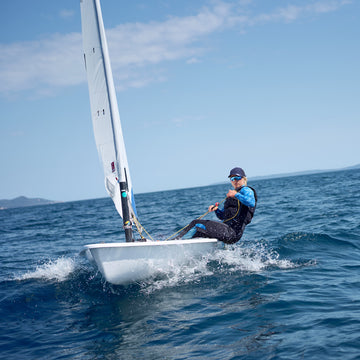
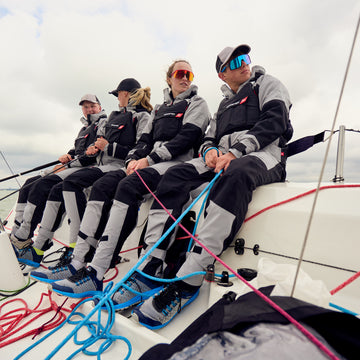
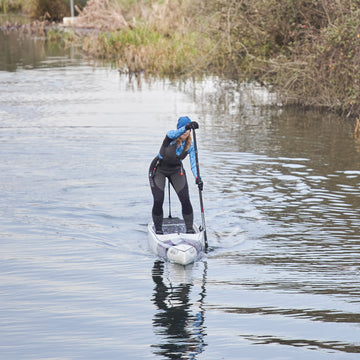
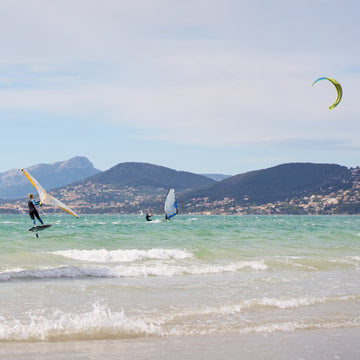
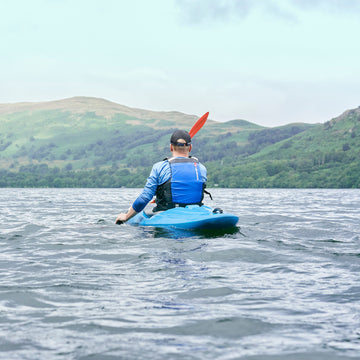
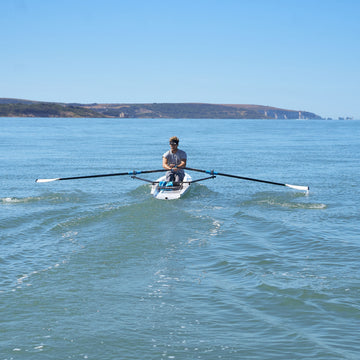
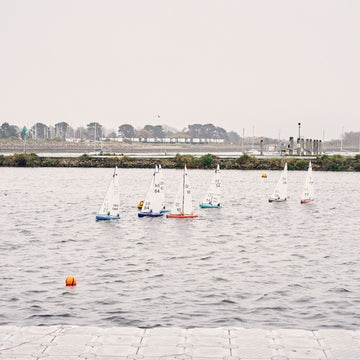
 Select Store
Select Store
 US
US
 UK
UK




